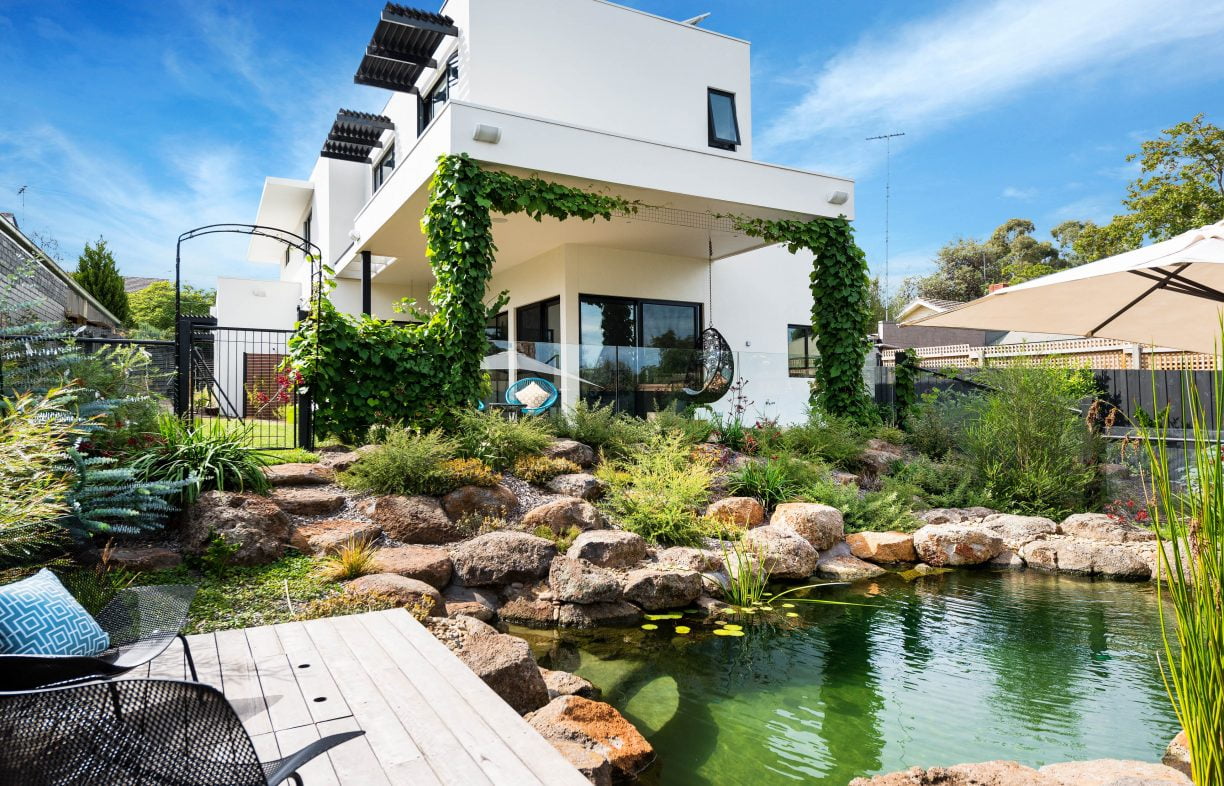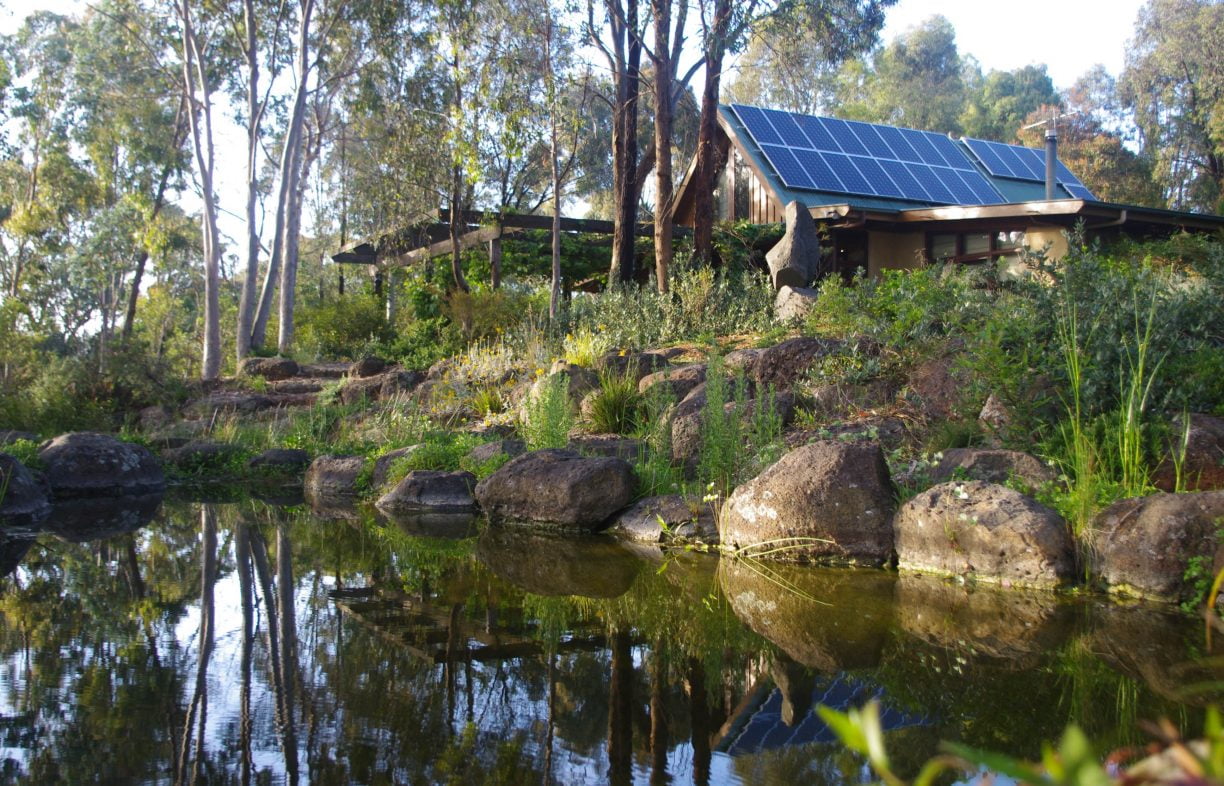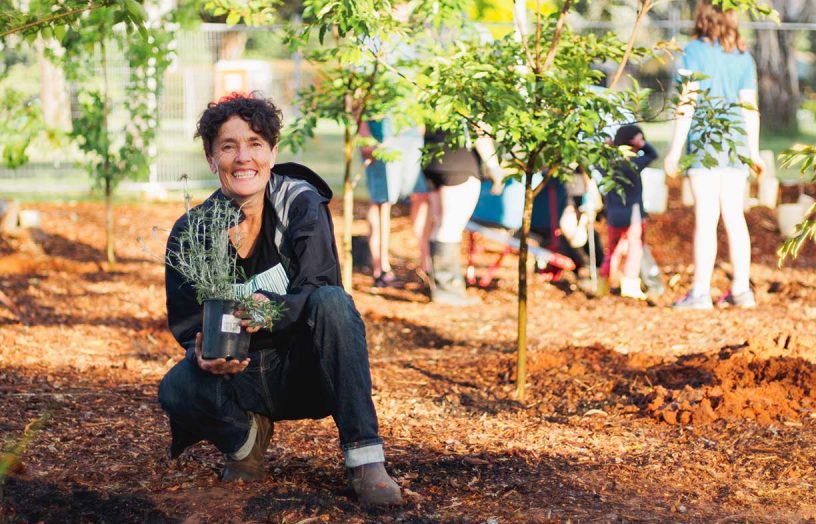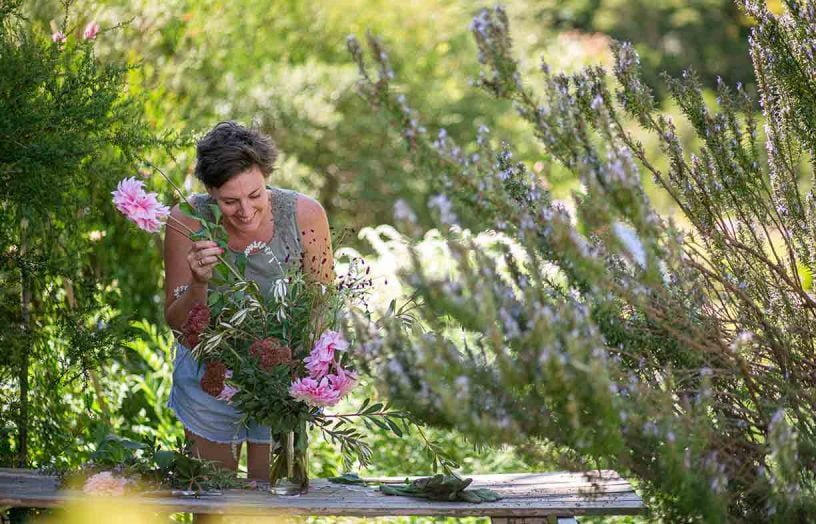Natural pools in depth

Natural pools are designed to minimise the environmental impact of backyard bathing, and are aesthetically beautiful too. With hundreds of these systems now installed in Australia, we find out how they work.
Swimming pools can get a bad rap when it comes to sustainability, notwithstanding their benefits for recreation and health. Their ongoing energy and water use can be immense, even for pools that are used sporadically.
But a growing number of households are changing this equation by installing chemical-free natural pools that use filtering systems that mimic nature. Rather than using chlorine to kill everything in the pool (except the swimmers!), a sustainable water quality is achieved by creating a balanced ecosystem.
Frances Cosway has included a natural pool in the garden of her sustainable home in Hampton, Victoria. “I always refer to it as our water feature that you can swim in,” says Frances. “It’s like swimming in a lake. There are tadpoles in there at the moment and dragonflies everywhere.”
The pool is nestled in a thriving native garden and in the natural setting looks like it’s always been there. Large boulders are used to form the pool edge, and water lilies and other aquatic plants grow out into the swimming space. The rounded pool shell itself is concrete with a layer of fine, sand-like pebble mix to blend in with the rocks. Rather than artificial blue, the crystal clear water is jewel-green. “The kids love swimming in it. For me, it is aesthetically beautiful all year round,” says Frances, but emphasises that it’s not for everyone. “A lot of people prefer blue pools that look very structured.”
Frances and her partner opened their home for Sustainable House Day 2016 and 2017 and the pool generated enormous interest. “As soon as you say it has no chlorine, people instantly assume it’s salt treated. Most visitors were not aware that you can get a pool with natural water without chlorine or salt.”
The term ‘natural pool’ can describe two different but not mutually exclusive concepts. It generally refers to pools with chemical-free ‘living’ water. The pool may resemble a pond or look just like a regular pool with a concrete or polypropylene shell, pool tiles and decks; either way, the water is alive and can have a water quality equal to or better than a mountain stream. Less commonly, the term is applied to chemically treated pools that blend in with the surrounding landscape.
Landscape designer Sam Cox, a proponent of naturalistic landscaping, has used both approaches. “What I’ve always wanted to do is bring the garden right in around the pool. With chemical pools we always had to have a buffer zone. We couldn’t bring the plants too close as the splashing would damage the plants,” he says. “With natural water, we can bring the plants right into the swimming space.”
How natural pools work
The science behind natural pools is well developed. Water is purified using a biological filter and fine filtration in combination with sophisticated hydraulic design, where water is moved constantly and circulated thoroughly. A ‘biofilm’ of beneficial bacteria lives in the biofilter (and parts of the pool before cleaning), and breaks down any organic matter using nitrification; plants then take up the resultant nitrate in competition with algae.
The constant flow and circulation of water maintains oxygen in the system and appropriate hydraulic design will avoid warm or stagnant patches developing. Good design will also focus heavily on maximising daily water pumping efficiencies: through evaporation these pools will lose a similar amount of water as a conventional pool, but generally use less energy per litre of water pumped.

Natural pools can be of any size, shape and depth, as long as the design allows the entire volume of water to pass through fine filtration and the biological filter. Creating a stable system is essential but can be tricky – there must be sufficient surface area for the microorganisms to live on (gravel for example) compared to water volume. “Like with a greywater system, we are emulating nature in some way. It’s about getting the balance right between water volume and how often it’s circulated through the system,” explains Sam Cox.
Sam has incorporated dozens of natural ponds, and now pools, into his landscapes over the past 20 years, and says it’s important to prioritise client education in order to set realistic expectations. “I grew up in the country where you swim in rivers and dams and lakes, so your expectation is very different compared to growing up swimming in urban swimming pools,” he says. “We had one client who thought he wanted a natural pool with natural water but then realised through the process that he was uncomfortable with it. The water in his pool was glass-clear and clean – but there were fragments of algal dust around the edges and he couldn’t make that shift.”
Design
Depending on how much space is available, a one- or two-pool system can be used: one is the swimming pool; a second is the biological pool and comprises gravel and plants (also known as the ‘regeneration zone’).
Jeff Knox from River Water Pools in Albury has designed his own two-pool system. His pool has several edges where, using gravity, the water overflows down through pipework to the fine filtration, before travelling through additional pipes to the bottom of the biofilter gravel bed, where it then rises up through the gravel to be pumped back into the pool. “I’ve used this system for 11 years and the water quality is very clear and good enough to drink,” he says. “The fine filtered up-flow gravel biofilter method means my water has a very low nutrient level and the gravel filter has never blocked because the water passes through the fine filter first.” Avoiding what a common problem in these systems.
For smaller urban spaces, compact European systems are available. Wayne Zwar of Natural Swimming Pools Australia has built 25 pools in Australia and is part of an international network using the BIOTOP ‘living water’ filtration system. The filters in these systems are generally tucked under a deck and perform the function of a biological filter without the need for an additional pool.

“Natural pools have been in Europe for over 30 years and we are accessing a lot of knowledge about them. There is a lot of specific equipment required to make these work in a backyard including a fantastic ‘biobox’ which means we don’t need huge gravel beds or plant areas.” Costs start at $80,000, but the ongoing costs are negligible. “The bulk of the cost is in the system we import from Austria. There’s obviously no ongoing cost for chemicals. The energy use for the pump is low, as we use a 12 volt German pump which is very efficient.”
Pool conversions and DIY
It is possible to build your own natural pool or convert an existing pool into a natural pool, but you need to check if yours is suitable first. A number of different companies offer conversion kits to help with this, each using a different system and method.
But be aware that design tips available online may not be directly applicable for your site or climate. In Australia, pools need to be designed to cope with rapid temperature rises through the day and often 40-plus degree temperatures in summer.
With an infrastructure investment upwards of $40,000 for DIY, it’s risky if you don’t understand what you’re doing or why you are doing it, according to Jeff Knox. “I have had enquiries from natural pool owners whose pools will not function properly, because the design was flawed from the beginning.”
Existing dams can be converted to natural pools, but their location is usually far from ideal – natural pools should never be positioned in spots that receive nutrient-rich surface water runoff.
For those just wanting to make the most of an existing swimming pool, converting it to a natural pool is one option, but there is also a movement in Australia (led by Ku-Ring-Gai council in New South Wales) to convert disused pools into ponds. If the water quality is maintained to a high level, these can also be used for swimming.
All swimming pools need to be built to Australian Standards and you should check with your council before construction. Increasingly local governments are not making a distinction between ‘pools’ and ‘ponds’, if the depth is greater than 300mm and they are located next to a house.
Maintenance
Like any system, maintenance is crucial but how much you need to do will depend on the type of system you have, and the desired water quality. As a rule of thumb, over a 24-hour period, the entire body of water will pass through the filters. Water levels can be topped up from the mains or onsite water storage.
Compared to conventional pools, natural pool maintenance is more about time than money. In warmer months, plant and algal growth is at its most prolific, and regular cleaning of filters, vacuuming and other maintenance is required. In cooler months, skimming leaves and general upkeep is still needed. Exceptionally low E.coli readings are possible in a well-designed system, as long as ducks are kept out of the water!
Natural pools can be heated to extend the swimming period. Frances Cosway’s pool is geared up for heating, but so far her family hasn’t taken advantage and instead uses the pool aesthetically in cooler months: “We use the pool all year – just not for swimming all year.”
Creating an ecosystem
While the original desire to swim in chemical-free water came from those with chlorine allergies, people wanting to return something to the environment are now embracing them. “Nature loves these pools,” enthuses Jeff Knox.
“What you are creating in your backyard is a small oasis,” says Wayne Zwar. “Instead of chopping trees down to put the pool in or paving metres of terracotta around it – by putting one of these in you’re building a mini ecosystem. You’re encouraging nature, not destroying it – from tiny insects right up the food chain to swallows (with the exception of mosquitos which don’t like moving water).”
He adds that this technology is so well accepted overseas that local authorities in England, Europe and the US are now building public pools using natural filtration.
More outdoors articles
 Outdoors
Outdoors
Pocket forests: Urban microforests gaining ground
Often no bigger than a tennis court, microforests punch above their weight for establishing cool urban microclimates, providing wildlife habitat and focusing community connection. Mara Ripani goes exploring.
Read more Outdoors
Outdoors
Nourished by nature: Garden design for mental health and wellbeing
There’s plenty of evidence that connection with nature is beneficial for both mind and body. We speak to the experts about designing gardens for improved mood and wellbeing, and what we can do at home to create green spaces that give back in a therapeutic way.
Read more Outdoors
Outdoors
In the line of fire: Plant list
Download a list of popular native species to accompany our Sanctuary 51 article 'In the line of fire: Garden design to reduce the threat of bushfire'.
Read more

